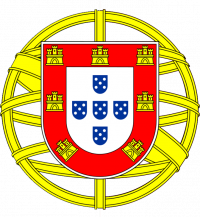The flag of Portugal is divided into two unequal parts of green and red, with green on the left. The line separating the colors depicts an armillary sphere and the Portuguese national emblem.
Flag of Portugal




The flag of Portugal is divided into two unequal parts of green and red, with green on the left. The line separating the colors depicts an armillary sphere and the Portuguese national emblem.
The flag of Portugal consists of:
The green and red colors predominate on the current flag of Portugal and were chosen to represent the new form of government, rather than the blue color previously used by the monarchy.
The green color occupies 1/3 of the flag and the red color 2/3, as it is reminiscent of the Iberian integrationist project. Thus, green is Portugal and red is Spain, united in a form of utopian federalism.
Armillary sphere (from Latin armilla - bracelet, ring) is an astronomical instrument for determining the coordinates of celestial bodies. It was introduced by King Manuel I (1495-1521) and represented the monarch as the king of the five continents. The armillary sphere was a stylization of the old globes used in the 16th century. It was also a personal symbol of Prince Henry the Navigator, who made a significant contribution to the development of navigation. The background of the sphere on the flag is that Portugal has experience in long-distance maritime exploration, having crossed the Atlantic Ocean and reached the American continent in the late 15th century. This period became known as the Age of Discovery. Therefore, the armillary sphere is a symbol of this achievement and appears on the Portuguese flag, separating green and red colors, in a golden frame.

The coat of arms in the form of a shield is the oldest symbol of Portugal and goes back to the very origins of the country, when it was still called Condado Portucalense. It consists of seven locks and five blue chevrons in the form of a shield on a white background. The seven yellow castles, each with three towers, represent existing castles located in the Algarve region of southern Portugal, overlooking the Atlantic Ocean:
The whole composition of the shield refers to the Portuguese victory over the Moors, who occupied the Iberian Peninsula from the 8th century onwards. The castles on the red background are fortifications of the territories reconquered by Portugal during the reign of Dominique Afonso Henriques, which were under the rule of the Moors. The blue chevrons represent the five Moorish kings defeated by the Portuguese. Inside each of these shields are bezants.
In heraldry, a bezant is depicted as a gold (yellow) or silver (white) circle representing a coin. They were originally used to represent the wealth of the Portuguese kingdom. King Afonso Henriques incorporated them into his coat of arms.The most common interpretation of this symbol is that it symbolizes the wounds of Jesus Christ. It was only under King Afonso III (1248-1279) that the shield took the form of a cross, which links Portugal to its Christian origins.
The current flag of Portugal was adopted in 1911, almost 800 years after the first official flag of the country, which dates back to 1143. At that time, the flag consisted mainly of white and blue, and around 1183, it was added with white and blue.
In the 13th century, the castles on the red stripe became part of the Portuguese flag, although in a different number and arrangement than today. Over the following centuries, the flag underwent several changes, especially during times of change of power, when the monarch on the Portuguese throne changed.

In the 15th century, for example, the shield was incorporated into the flag along with the royal crown. During the reign of Don Manuel, the armillary sphere became his personal flag. This symbol was not yet part of the national flag.
Portugal adopted the new flag during the Iberian Union, a political period marked by the unification of the Spanish and Portuguese crowns between 1580 and 1640. Another time when the national flag underwent significant changes was in the early 19th century, when Brazil was elevated to kingdom status, thus creating the United Kingdom of Portugal, Brazil and the Algarve. The flag consisted of the Portuguese coat of arms, an armillary sphere, and a crown.

The last flag of the Portuguese monarchy had a blue and white background - the colors that represented this regime of government in the country, as well as the royal coat of arms and crown. Green and red became the national colors as soon as a new republican regime was established in Portugal on October 5, 1910.
The same year, a commission was set up to design a new flag for the country, which was approved on November 29. It was officially adopted by the government on June 19, 1911.